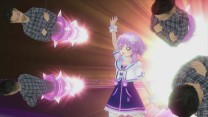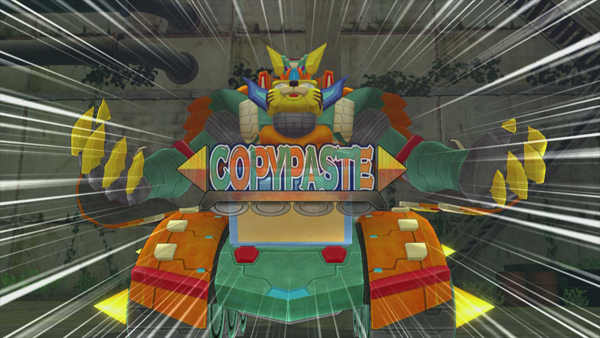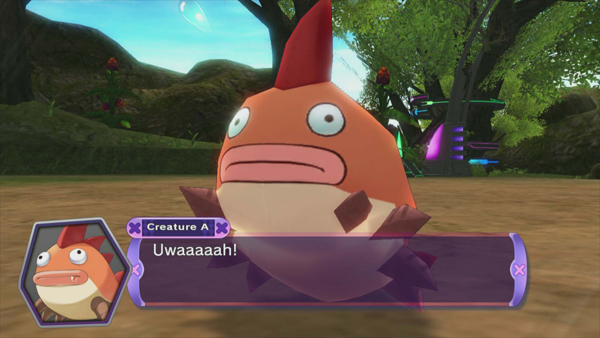The game-consoles-as-girls are back, and they’re out for revenge! Or something less severe. Naps, sisterhood, and industry quarreling, chiefly. Welcome to Hyperdimension Neptunia Victory, the third installment in the fourth wall-breaking series.
If you’re new to Neptunia, see my Mk2 review for a more thorough appraisal of the concept. If you’d like a more concise explanation: Hyperdimension Neptunia Victory, henceforth Victory, takes place in Gamindustri, a parody of the real world industry where video game consoles and developers are personified in girls who fight for great justice. The CPUs, those girls who are goddesses and reign over nations, represent Sony, Nintendo, Microsoft and Sega’s home consoles.
The self-proclaimed protagonist, Neptune—Nep-Nep, Neptuna and who knows what else in local vernacular—represents the aborted Sega console by the same name. Come to think of it, the fact that the console was aborted may go far in explaining her delightfully goofy, hair-brained personality and complete lack of respect for the fourth wall. Actually, I should touch the topic of the localization while I’m discussing Neptune. I’ve done extensive research on English slang, and while her dialogue can certainly be improved upon, I can appreciate the work that went into writing the character’s English script. She wields a lexicon of slang, broken idioms and improvised words that would make me happy as a clam at high tide if I could feel such a thing. Still, here’s a nod from me, NIS America.
So the story begins with our supposed protagonist lazing around, being haggled for the lazing, and generally being a good-for-nothing until—schlurp—she’s sucked into an alternate dimension some two decades in the past. Enter the gauzy, air-headed Plutia (then goddess of Sega’s nation) and tsundere Noire (eventually goddess of Sony). Gamindustri has only just begun to prosper here, and poor Neptune has no choice but to make the best of it; though, all things considered, her near constant levity only gives way briefly to confusion. So it goes that you’re eventually mired in the alternate world’s problems as one of two CPUs governing Planeptune. The Seven Sages seek to usurp the power of the CPUs and introduce a society that isn’t governed by what amounts to a matriarchy of divine beings. I imagine their mantra is akin to something those liberal non-conformists would say: “Down with the (wo)man” or what-have-you.
Like the previous games, the story is hardly worth a shrug. It’s just a steak on a stick meant to lure players further along the predetermined path. And that’s okay. If you’re playing the Neptunia titles for the story, well, I suppose you’re already lost to the world. I’ll make a supersonic man out of you. What is noteworthy, however, is the way in which the story is presented. Unlike Mk2, which spent too much time preaching anti-piracy and being a stinking pile of humdrum, Victory is buoyant, tongue-in-cheek, bombastic, and rarely takes itself seriously. I actually chuckled at Nepgear, Mk2’s returned protagonist, once. A reserved chuckle, but a chuckle nonetheless. The affinities she gains throughout the story are superfluous, but paired with her infatuation with robots, they give the girl personality she did not have in her own title. New characters like the bombilating Peashy, pusillanimous Rei and high strung Copypaste bring some fresh charm to the series and remind us what Compile Heart is good at..
In that way, Victory is a return to form. It harkens to the mood and execution of the first game. The fourth wall is regularly prodded, the banter is reliably cheeky, and the characters seem comfortable there, in the bedlam—or uncomfortable when the otherwise harmless Plutia reveals her pleasantly sadistic side.
As far as appearances are concerned, Victory is principally a polished experience. This is especially notable in the interface, which is on par with the slickness of, say, Persona 4. There is a bit of a chasm—if there can be a bit of those—between environment and character design, but it’s nothing to carp over. The title looks fantastic. It’s colorful, if sometimes too colorful. The bloom could be turned down a notch. Albeit, there’s a great deal of recycling done throughout levels, going as far as reusing areas from the previous title. Something noteworthy: weapon appearance changes with every weapon. I’ve always appreciated that in role-playing games. It’s the little things.
Skulking through these environments, bonking monsters from behind for high initiative rolls, and engaging in combat is all very familiar to anyone who’s played Mk2. It isn’t perfect, but it gets the job done.
Once you’ve entered fisticuffs, character positioning is an abstract affair. Typically, you’ll want to attack from behind and avoid grouping together. Most of my tough encounters ended in a quincunx formation, monster in the middle. Surround ‘n’ pound, I’ll call it. Battle abilities differ vastly between characters, and if there’s anything skirmish-related to praise Victory over, it’s that the buff and debuff skills are actually useful. Bosses aren’t often immune to debuffs, which means you’ll end up using the skills that might have gone untouched in another game.
But combat isn’t so simple. You’ll have a sufficient cache of options opened up over time. First, there’s the whole customization of your combos. There are three groups: those with high number of hits, those with high power, and those that focus on breaking a monster’s guard—the bar below HP that acts as a damage buffer. Think of it as the overprotective parent preventing you from getting in the trousers of the stud next door. It’s a nice enough system, though I still haven’t found a use for the high hit attacks. I’m willing to surrender that I could be missing something there.
Eventually you’ll unlock the EXE Drive Gauge, which serves two purposes. It’s a shared limit break bar, if you will, used to unleash EXE Drive attacks: super, over-the-top hack fests that inflict obscene amounts of damage. It also serves to unlock EX Finishes, those final blows that inflict extra damage with proper but not confetti-and-balloons flair. So it’s usually a good idea to keep your EXE bar full in order to enable more powerful basic combinations until you’re ready for maximum penetration. Then you go for an all-out attack and strike while the iron’s hot.
There’s a magazine of unspent bullet points that need to be addressed for a variety of reasons. So I’ll do that here.
The “challenge” system is new to Victory, and a most welcome addition at that. You’re given a large number of goals with each character, such as run [x] distance, take [x] damage, jump [x] times that progress in levels and give you passive bonuses to stats in addition to unlocking voices. It’s a neat enough concept that doesn’t hurt the game at all and satisfies the player in much the same way that leveling up does.
Lily ranks have been met with some improvement in Victory. They’re basically backseat pairings wherein the inactive member imparts the battle member with certain bonuses, abilities and skills. Consider them friendship levels: whether or not heroine A thinks heroine B is an insufferable yazzihamper. My only complaint here is that lily ranks take a copious amount of battles to increase. Hooray hour padding. Still, it’s a good use for those cohorts not in the active party.
At some point in the game you’ll be able to make game discs that provide your characters with a wide array of bonuses. It’s very basic, so there isn’t much to say here other than it works. As far as CH games are concerned, you generally want to mention when something works. It works.
The scouting system is both a welcome addition and a friggin’ absurd example of how Compile Heart just cannot fathom a video game in which the player does not suffer. You gain access to the system early on, and are given very little direction in how exactly it works. Chiefly because you have very little control over what’s going on to begin with. You send scouts out to map points to explore and bring back random rewards, be it changes in the map, items, money or new locations. Generally, that’d be a great supplemental gameplay element. As its own entity, it’s nifty enough. The trouble is that it’s entirely random; there are no parameters to tinker with.
What makes that an even bigger problem is the abysmal quest system. Absolutely abysmal. Quests either ask that you kill a monster of some type or bring home a sack of requested loot—the gnarly parts of monsters you’ve not-so-surgically severed after battle. The real catch is that most quests give you no idea where to find the monsters or what drops the loot. Quest descriptions are generally notes left by the client: “I think this girl is smokin’. Bring me three toad tongues.” To worsen the problem, many target monsters only appear when a scout returns from a dungeon to report that they’ve found a “tough” or “risky” foe; this does not happen often. If that wasn’t painful enough, many dungeons have flags that, when raised or lowered, will trigger different scout results.
Oh, and to amplify the issue, drop rates are downright maddening. I found myself farming mobs as if I were playing an MMO. Come on, CH; we all know you’re just padding hours at this point. It’s low, and a poor excuse for content when you have to resort to such crude measures. This is only made worse by the existence of item development. That’s right: you can make items out of the items that won’t drop!
The disparity between parts of Victory remains flummoxing, even if I’ve come to expect this of Compile Heart. It’s hard to tell whether they’re trying their best or are one of those types who think glaring flaws are handsome. While I am inclined to agree, I don’t necessarily think that applies to video games. Still, I’ll have to take a step back to avoid missing the forest for the trees. In Victory you have a game whose whole is better than its parts. Blithesome, flippant, silly and well aware, Victory will satisfy gamers looking for a light-hearted JRPG romp.






